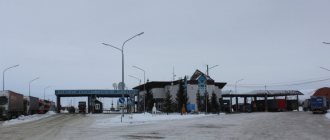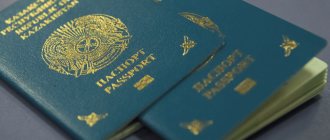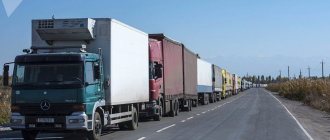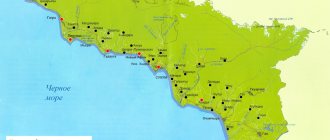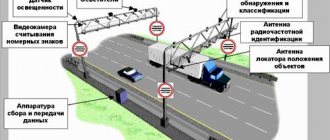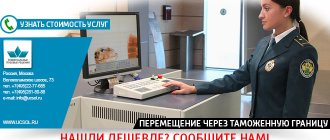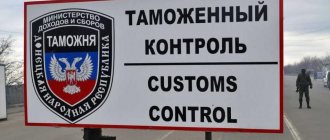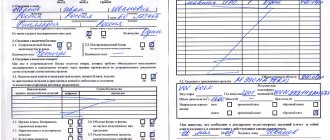Database of Customs/t/p MAPP Matveev Kurgan
| Status | Change of subordination (changed 09/30/2020) |
| Customs authority code | 10319060 (valid from 09/14/2006) |
| Name | t/p MACP Matveev Kurgan |
| Full name | customs post of MAPP Matveev Kurgan |
| Organizational-structural form | Customs authority (not specialized) |
| City | S.AVILO-USPENKA |
| Postcode | 346810 |
| Address | 346810 ROSTOV REGION, MATVEEVO-KURGAN DISTRICT, S.AVILO-USPENKA |
| Telephone | (8634)32-52-12 |
| Fax | (8634)32-52-55 |
| OKATO code | 60000 |
| SOATO code | 1160 (ROSTOV REGION) |
Software for customs clearance.
Programs for declarants and other participants in foreign trade activities Tamplat.ru - customs payments. Calculator for calculating customs duties
D.TKS.RU – online training center for professionals working with customs authorities
197022, St. Petersburg, st. Petropavlovskaya, 4-a, business, 3rd floor, metro station "Petrogradskaya" t., f.,, www.tks.ru
Training license No. 1458 dated July 30, 2015
Source
Contacts and details
| Name | Customs post of railway border crossing point Uspenskaya |
| Customs code | 10313190 |
| Organizational structural form | Customs authority (not specialized) |
| Customs clearance | produced |
| Parent's name | Rostov customs |
| Short name | t/p railway station Uspenskaya |
| Full address | 347900, Rostov region, Taganrog, st. Frunze, 81D |
| Telephone | +7 |
| Website | https://yutu.customs.ru/folder/152045 |
| Working with ATA carnets | No |
| OKATO code | 60000 |
| SOATO code | 1160 |
Customs post "Matveev Kurgan"
The Matveev Kurgan customs post has been registered with internal federal authorities since September 14, 2006. At this checkpoint, customs clearance of goods is carried out for both exporters and imports. The checkpoint is located on the territory of the village of Avilo-Uspenka and provides customs control on a number of federal highways. There are no railway control zones at this checkpoint. You can contact customs post employees to clarify details of cargo clearance by calling +88634435410 in the Rostov region.
When traveling from the DPR to Russia or, conversely, coming to us from Russia, it is often faster and easier to take local public transport to the border crossing, cross the border on foot, and then transfer to a commuter train or bus on the other side. Moreover, this option is also the cheapest: the cost of a direct bus route crossing the border can exceed the total cost of travel to and from the border by internal regular transport by 2-3 times.
The DPR operates several checkpoints on the border with the Russian Federation, three of which are international: Marinovka, Novoazovsk and Uspenka. Pedestrians are allowed to cross the border at all of them, but not everywhere and not always this method of crossing it is convenient. Only one – “Uspenka” – is served by local public transport from Taganrog, Donetsk and Amvrosievka, but at the border crossings “Marinovka” and “Novoazovsk” it is absent from the word “completely”. Moreover, both from our side and from the Russian side...
By bus and taxi
Most recently, bus service on the route “Donetsk – Avilo-Uspenka” was resumed in Donetsk. Flights from the Yuzhny bus station operate daily.
The first bus departure from the Yuzhny bus is at 05:50 (arrival at 08:05), from Avilo-Uspenka - at 09:20.
The second departure from Yuzhny is at 12.45 (arrival at 15:00), leaving Avilo-Uspenka at 16.00 - this is the last bus trip.
A bus ticket costs 145 rubles, on the day of departure the price is 130 rubles. True, at the Yuzhny box office they warn that it is better to purchase tickets in advance, since in the summer this direction is in special demand and tickets may not be available on the same day.
The distance from Donetsk to Avilo-Uspenka is almost 100 kilometers. With private carriers you can get to the border for 1,200 rubles one way; you will have three or four other fellow travelers in the car with you.
If you travel individually, the price of a one-way trip will be 2000–2500 rubles.
“You can also use a taxi. The trip will cost between 2100–2500 rubles. “A trip from the Central Clinical Hospital to Uspenka will cost you 2,300 rubles,” said the dispatcher of one of the Donetsk taxi services.
The advantages of traveling by car: you will be picked up directly from your address (or delivered to your address) and the travel time will be one hour - this is a couple of hours less than if you travel by bus.
Having reached Uspenka, you need to prepare for the fact that crossing the border on foot may take a couple of hours, or even more: it all depends on the congestion of the Russian side of the border crossing with buses, during the break between which pedestrians are released. However, having passed all the inspections, you need to think about how to go further: a taxi to Taganrog costs the same 2000–2500 rubles, and a suburban bus runs only twice a day, and it can be problematic to squeeze into it. Therefore, most pedestrians head to Uspenskaya station, from where six pairs of electric trains run per day. From the border crossing it’s half an hour on foot, and by taxi it’s only a few minutes, and this pleasure costs only fifty rubles per person.
You can get there by train
The most punctual and cheapest option is the train. A passenger who uses this method of travel from Donetsk to Rostov is guaranteed to spend eleven hours on the road with all transfers, while someone who pays ten times the amount for a taxi can spend the same eleven hours only on crossing the border itself. The arrival of a bus passing the border along a separate corridor (taxis and minibuses stand in a general queue) will also most often be late, although, according to the recollections of frequent travelers, there are also times ahead of schedule. The latter, by the way, is not always something to be happy about, especially if on the way back from Rostov to Donetsk the flight arrived before the end of the curfew.
You can also get to the border by rail - by train No. 619/620 Yasinovataya - Uspenskaya. The ticket price is reasonable: 42 rubles for a general carriage ticket, reserved seat – 65 rubles. Plus 12 rubles must be paid for crossing the border. It is advisable to buy tickets in advance, especially in summer.
Many Donetsk residents board it at the railway station in Makeyevka; it arrives here at 08.16 and departs literally two minutes later. The train makes stops in Krinichnaya, Khanzhenkovo, Khartsyzsk, Ilovaisk, Kuteinikovo, Amvrosievka, Kvashino and arrives at Uspenskaya station at 11.30. He leaves Uspenskaya at 13.30 and arrives in Makeevka at 16.49.
“If you didn’t catch the return train at 13.30, then you will have to take a bus from Uspenka back to Makeevka,” the ticket office said.
As the married couple said on the platform of the Makeevka railway station, they bought tickets just before the train departed. The man says that he bought household appliances in Russia, one part broke down, which he is going to replace under warranty.
Young people heading to Taganrog are talking under the shade of trees while waiting for the coveted train.
“We are going by train to Uspenka for the first time, and there we will change trains in Russia. We decided to spend our summer holidays in Taganrog. This is our first time going by train, previously only by bus,” says one of the girls, Tatyana.
The village of Avilo-Uspenka, in which the Uspenskaya station is located, is a border zone, and, therefore, you should not move beyond the station square and a couple of neighboring blocks. Two shops, a cafe - that’s the whole range of places to hang out. A very peculiar “indicator” of the arrival of a train from Yasinovataya is the length of the queue at the “house of an unknown architect”: between the border stations of Kvashino and Uspenskaya there is a sanitary zone, the cars are not equipped with vacuum systems, so you have to wait a couple of hours... In principle, it would be possible for the convenience of passengers build a structure with greater capacity: the surrounding area clearly demonstrates that during peak load hours the available capacity is clearly insufficient.
About an hour after the arrival of the Yasinovat train, boarding begins on the train heading to Rostov via Taganrog. 245 rubles for a ticket, three and a half hours of contemplating the landscapes outside the window - and we are on the banks of the Don. To Taganrog it will be exactly twice as cheaper and faster. By the way, when boarding the train, your documents are checked.
What about the neighbors?
The Lugansk People's Republic also has three international border crossings with Russia: Izvarino, Chervonopartizansk and Dolzhansky. All three are vehicular, all three allow pedestrians. Local railway communication with the Rostov region among Lugansk residents ceased several years before the war and has not yet been restored.
The most important difference: all three border crossings in the LPR are served by regular transport, and from both sides of the border. You can get to the Dolzhansky checkpoint three times a day by commuter buses both from Sverdlovsk, in the LPR, and from the Russian Novoshakhtinsk. From the checkpoint "Chervonopartizansk" on both sides of the border, regular transport stops are located a bit far away, a couple of kilometers away, but six times a day a direct suburban bus Gukovo - Sverdlovsk runs across the border, costing just over a hundred rubles, and local taxi drivers are more expensive than a hundred per person they don't ask.
But the analogue of our “Uspenka” among Lugansk residents is the “Izvarino” checkpoint, located on the outskirts of Krasnodon of the same name. Pedestrian traffic there is very intense: on the other side of the border, the city of Donetsk in the Rostov region immediately begins.
You can get to the border crossing from the center of both cities by regular city minibus. But something else is also noteworthy: from the overpass of the railway station in Lugansk to the Izvarino checkpoint there are 21 (!) bus trips daily. The first one leaves at 5.25, the last one at 18.15, the fare costs 91 rubles. An example worthy of imitation...
Price
One consignment of goods is understood as a consignment of goods sent at a time to the consignee using one waybill in one vehicle within the framework of one foreign trade contract.
| Type of work | Cost without VAT) |
| Carrying out customs operations and customs declaration of goods of one consignment in import mode (IM 40): - consulting on customs clearance issues; — checking the package of documents provided by the Customer for customs clearance of one consignment (including shipping documents); — formalization of delivery documents, preparation, filling out the declaration form and electronic submission to the customs authority. | from 5,000 rubles |
| Carrying out customs operations and customs declaration, in relation to each subsequent consignment in import mode, if there are several consignments in one vehicle (IM 40): - consulting on customs clearance issues; — checking the package of documents provided by the Customer for customs clearance of one consignment (including shipping documents); — formalization of delivery documents, preparation, filling out the declaration form and electronic submission to the customs authority. | from 4,000 rubles |
| Registration of each additional sheet of goods declaration, starting from the 5th (fifth) product in the import mode (IM 40). | from 450 rubles |
| Carrying out customs operations and customs declaration of goods of one consignment in export mode (EC 10): - consulting on customs clearance issues; — checking the package of documents provided by the Customer for customs clearance of one consignment (including shipping documents); — formalization of delivery documents, preparation, filling out the declaration form and electronic submission to the customs authority. | from 3,000 rubles |
| Carrying out customs operations and customs declaration of goods of one consignment (other regimes): - consulting on customs clearance issues; — checking the package of documents provided by the Customer for customs clearance of one consignment (including shipping documents); — formalization of delivery documents, preparation, filling out the declaration form and electronic submission to the customs authority. | from 10,000 rubles |
| Payment (additional payment) of any types of customs duties under one DT on behalf and on behalf of the Customer, during customs declaration of the Customer’s goods, using the Customs Representative’s own funds through terminal payment using a customs card/online service of the ROUND payment system. | from 3% of the documented payment amount (additional payment), but not less than 1,000 rubles |
| Assistance in obtaining a Declaration of Conformity with the CU TR for goods, as well as other permitting documents. | discussed individually |
Customs broker services
- Personal customs clearance specialist;
- We prepare and execute the necessary documentation - declarations, applications, various permitting forms, documents, reporting;
- Recommendations on HS codes for goods;
- Preliminary calculation of customs value and amount of advance customs payments;
- Drawing up DT projects and related documents;
- Document flow with customs;
- Submission of information at the request of the Customs post of MAPPA Matveeva Kurgan;
- Representation of the Customer's interests in the customs authorities of the Russian Federation;
- Organization, if necessary, of preliminary customs inspection of goods and vehicles before submitting the DT;
- Drawing up a declaration of intent under the seal of the customs representative;
- Consulting in the field of foreign economic activity (FEA);
Rules for customs clearance due to Coronavirus (Ukraine / Crimea / Russia / DPR / LPR)
Passage of borders from Crimea to Ukraine (checkpoint Armyansk - Kalanchak, Chaplynka, checkpoint Dzhankoy-Chongar)
Russia allows re-entry only through the humanitarian corridor, which arises in the following cases: - first-degree relatives live in Ukraine (parents, children, spouses);
- care for a first-degree relative is required;
— planned treatment in Ukraine. In this case, you can serve your observation at this medical institution;
— real estate in Ukraine;
-training in Ukraine.
All these circumstances must be documented and justified.
This information was collected for informational purposes; in unusual situations, if questions arise, to clarify the list of documents, it is recommended to contact the Border Department of the Republic of Crimea.
Passing customs from Ukraine to Crimea (checkpoint Armyansk - Kalanchak, Chaplynka, checkpoint Dzhankoy-Chongar)
What you need to know and what documents you need to have to cross the border if you are traveling from Ukraine to Crimea during quarantine
— relatives of the first degree of kinship live in Ukraine (parents, children, spouses);
- care for a first-degree relative is required;
— planned treatment in Crimea;
— real estate in Crimea;
- work, study in Crimea.
All these circumstances must be documented and justified.
This information was collected for informational purposes; in unusual situations, if questions arise, to clarify the list of documents, it is recommended to contact the Border Department of the Republic of Crimea.
Passing customs from the DPR to Russia (Uspenka-Avilo-Uspenka checkpoint, Marinovka-Kuibyshevo checkpoint, Novoazovsk-Veselo-Voznesenka checkpoint)
What you need to know and what documents you need to have to cross the border if you are heading from Russia to Donetsk during quarantine
Across the border on transfer roads: how can residents of the DPR get to the Uspenka checkpoint and back?
When traveling from the DPR to Russia or, conversely, coming to us from Russia, it is often faster and easier to take local public transport to the border crossing, cross the border on foot, and then transfer to a commuter train or bus on the other side. Moreover, this option is also the cheapest: the cost of a direct bus route crossing the border can exceed the total cost of travel to and from the border by internal regular transport by 2-3 times.
The DPR operates several checkpoints on the border with the Russian Federation, three of which are international: Marinovka, Novoazovsk and Uspenka. Pedestrians are allowed to cross the border at all of them, but not everywhere and not always this method of crossing it is convenient. Only one – “Uspenka” – is served by local public transport from Taganrog, Donetsk and Amvrosievka, but at the border crossings “Marinovka” and “Novoazovsk” it is absent from the word “completely”. Moreover, both from our side and from the Russian side...
By bus and taxi
Most recently, bus service on the route “Donetsk – Avilo-Uspenka” was resumed in Donetsk. Flights from the Yuzhny bus station operate daily.
The first bus departure from the Yuzhny bus is at 05:50 (arrival at 08:05), from Avilo-Uspenka - at 09:20.
The second departure from Yuzhny is at 12.45 (arrival at 15:00), leaving Avilo-Uspenka at 16.00 - this is the last bus trip.
A bus ticket costs 145 rubles, on the day of departure the price is 130 rubles. True, at the Yuzhny box office they warn that it is better to purchase tickets in advance, since in the summer this direction is in special demand and tickets may not be available on the same day.
The distance from Donetsk to Avilo-Uspenka is almost 100 kilometers. With private carriers you can get to the border for 1,200 rubles one way; you will have three or four other fellow travelers in the car with you.
If you travel individually, the price of a one-way trip will be 2000–2500 rubles.
“You can also use a taxi. The trip will cost between 2100–2500 rubles. “A trip from the Central Clinical Hospital to Uspenka will cost you 2,300 rubles,” said the dispatcher of one of the Donetsk taxi services.
The advantages of traveling by car: you will be picked up directly from your address (or delivered to your address) and the travel time will be one hour - this is a couple of hours less than if you travel by bus.
Having reached Uspenka, you need to prepare for the fact that crossing the border on foot may take a couple of hours, or even more: it all depends on how busy the Russian side of the border crossing is with buses, during the break between which pedestrians are released. However, having passed all the inspections, you need to think about how to go further: a taxi to Taganrog costs the same 2000–2500 rubles, and a suburban bus runs only twice a day, and it can be problematic to squeeze into it. Therefore, most pedestrians head to Uspenskaya station, from where six pairs of electric trains run per day. From the border crossing it’s half an hour on foot, and by taxi it’s only a few minutes, and this pleasure costs only fifty rubles per person.
You can get there by train
The most punctual and cheapest option is the train. A passenger who uses this method of getting from Donetsk to Rostov is guaranteed to spend eleven hours on the road with all transfers, and someone who pays ten times the amount for a taxi can spend the same eleven hours only on crossing the border itself. The arrival of a bus passing the border along a separate corridor (taxis and minibuses stand in a general queue) will also most often be late, although, according to the recollections of frequent travelers, there are also times ahead of schedule. The latter, by the way, is not always something to be happy about, especially if on the way back from Rostov to Donetsk the flight arrived before the end of the curfew.
You can also get to the border by rail - by train No. 619/620 Yasinovataya - Uspenskaya. The ticket price is reasonable: 42 rubles for a general carriage ticket, reserved seat – 65 rubles. Plus 12 rubles must be paid for crossing the border. It is advisable to buy tickets in advance, especially in summer.
Many Donetsk residents board it at the railway station in Makeyevka; it arrives here at 08.16 and departs literally two minutes later. The train makes stops in Krinichnaya, Khanzhenkovo, Khartsyzsk, Ilovaisk, Kuteinikovo, Amvrosievka, Kvashino and arrives at Uspenskaya station at 11.30. He leaves Uspenskaya at 13.30 and arrives in Makeevka at 16.49.
“If you didn’t catch the return train at 13.30, then you will have to take a bus from Uspenka back to Makeevka,” the ticket office said.
On the platform of the Makeevsky railway station, a Vecherka correspondent meets a married couple. They bought tickets just before the train departed. The man says that he bought household appliances in Russia, one part broke down, which he is going to replace under warranty. Young people heading to Taganrog are talking under the shade of trees while waiting for the coveted train.
“We are going by train to Uspenka for the first time, and there we will change trains in Russia. We decided to spend our summer holidays in Taganrog. This is our first time going by train, previously only by bus,” says one of the girls, Tatyana.
The village of Avilo-Uspenka, in which the Uspenskaya station is located, is a border zone, and, therefore, you should not move beyond the station square and a couple of neighboring blocks. Two shops, a cafe - that’s the whole range of places to hang out. A very peculiar “indicator” of the arrival of a train from Yasinovataya is the length of the queue at the “house of an unknown architect”: between the border stations of Kvashino and Uspenskaya there is a sanitary zone, the cars are not equipped with vacuum systems, so you have to wait a couple of hours... In principle, it would be possible for the convenience of passengers build a structure with greater capacity: the surrounding area clearly demonstrates that during peak load hours the available capacity is clearly insufficient.
About an hour after the arrival of the Yasinovat train, boarding begins on the train heading to Rostov via Taganrog. 245 rubles for a ticket, three and a half hours of contemplating the landscapes outside the window - and we are on the banks of the Don. To Taganrog it will be exactly twice as cheaper and faster. By the way, when boarding the train, your documents are checked.
What about the neighbors?
The Lugansk People's Republic also has three international border crossings with Russia: Izvarino, Chervonopartizansk and Dolzhansky. All three are vehicular, all three allow pedestrians. Local railway communication with the Rostov region among Lugansk residents ceased several years before the war and has not yet been restored.
The most important difference: all three border crossings in the LPR are served by regular transport, and from both sides of the border. You can get to the Dolzhansky checkpoint three times a day by commuter buses both from Sverdlovsk, in the LPR, and from the Russian Novoshakhtinsk. From the Chervonopartizansk checkpoint on both sides of the border, regular transport stops are located a bit far away, a couple of kilometers away, but six times a day a direct suburban bus from Gukovo to Sverdlovsk runs across the border, costing just over a hundred rubles, and local taxi drivers don’t cost more than a hundred per person. they ask.
But the analogue of our “Uspenka” among Lugansk residents is the “Izvarino” checkpoint, located on the outskirts of Krasnodon of the same name. Pedestrian traffic there is very intense: on the other side of the border, the city of Donetsk in the Rostov region immediately begins. You can get to the border crossing from the center of both cities by regular city minibus. But something else is also noteworthy: from the overpass of the railway station in Lugansk to the Izvarino checkpoint there are 21 (!) bus trips daily. The first one leaves at 5.25, the last one at 18.15, the fare costs 91 rubles. An example worthy of imitation...
Victoria Lev, Donetsk Evening newspaper
Tags: RussiaTransportUspenka
